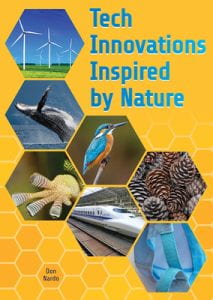 Nardo, Don. Tech Innovations Inspired by Nature. Reference Point Press, 2024. 978-1-678-20608-6. 64 p. $33.05 Grades 7-12.
Nardo, Don. Tech Innovations Inspired by Nature. Reference Point Press, 2024. 978-1-678-20608-6. 64 p. $33.05 Grades 7-12.
Most people have heard the story of how a scientist went hiking and returned frustrated by the burrs that clung to his clothing and his dog’s fur. Curious, he examined how the burrs clung so successfully. The resulting invention was velcro, a useful fastener now utilized worldwide. Although we may know this origin story, there are numerous other innovations which have been or which are currently being investigated for usefulness to humans. Biomimicry “allows people to learn from and apply nature’s handiwork to fulfill human needs” (5). Nardo details some of these in chapters dedicated to: engineering and construction; medical applications; protective gear for soldiers and athletes; energy; and robotics. Some examples are: barbed wire is based upon the briar; the femur aided Eiffel’s tower design; the kingfisher’s beak improved the speed and sound of Japanese high-speed bullet trains; and Gila monster’s venom has been used to create effective medicine for diabetes and weight loss. The examples are plentiful, and will intrigue readers interested in nature, engineering, and tinkering. Nature, it seems, may hold solutions to many human problems.
THOUGHTS: This thorough book provides so many instances of biomimicry that it may change what readers “see” while outdoors or with animals, and it is perfect for inspiring STEAM-related careers. Highly recommended.
660.8 Engineering

